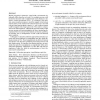Free Online Productivity Tools
i2Speak
i2Symbol
i2OCR
iTex2Img
iWeb2Print
iWeb2Shot
i2Type
iPdf2Split
iPdf2Merge
i2Bopomofo
i2Arabic
i2Style
i2Image
i2PDF
iLatex2Rtf
Sci2ools
105
click to vote
VR
2011
IEEE
2011
IEEE
Self-motion illusions in immersive virtual reality environments
Motion perception in immersive virtual reality environments significantly differs from the real world. For example, previous work has shown that users tend to underestimate travel distances in immersive virtual environments (VEs). As a solution to this problem, some researchers propose to scale the mapped virtual camera motion relative to the tracked real-world movement of a user until real and virtual motion appear to match, i. e., real-world movements could be mapped with a larger gain to the VE in order to compensate for the underestimation. Although this approach usually results in more accurate self-motion judgments by users, introducing discrepancies between real and virtual motion can become a problem, in particular, due to misalignments of both worlds and distorted space cognition. In this paper we describe a different approach that introduces apparent self-motion illusions by manipulating optic flow fields during movements in VEs. These manipulations can affect self-motion...
| Added | 22 Aug 2011 |
| Updated | 22 Aug 2011 |
| Type | Journal |
| Year | 2011 |
| Where | VR |
| Authors | Gerd Bruder, Frank Steinicke, Phil Wieland |
Comments (0)

